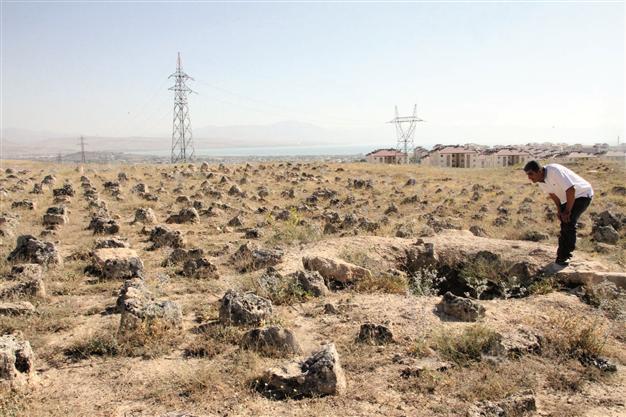Stonehenge of Anatolia in need of attention
VAN - Anadolu Agency

The stones, which were placed with great attention
just like the ones at Britain’s Stonehenge, were also used in astronomy during the Urartian era.
An area of 1,600-squaremeters, where more than 2,000 stelas have been erected by the Urartian Kingdom through mathematical calculations, and underground rock graves need attention to contribute to Turkish tourism.
The structures, which date back to 3,000 years ago when the Urartians lived in the region in the eastern province of Van’s Tuşba district, shed light on the lifestyle of the past, as well as scientific work in the ancient era.
Round stonesThe stelas and stone circles, located in the necropolis (graveyard) area 1.5 kilometers northeast of the Kalecik neighborhood, reveal that the Urartian people dealt with the science of astronomy. The area is home to round stones and differ in 13-40 meter diameters, and 25 underground graves, as well as 2,475 stelas.
Yüzüncü Yıl University Head of Archaeology Department Associate Professor Rafet Çavuşoğlu said the 20-500 kilograms of stones, which were brought from the stone pits on the Şahbağı Hill, were placed in the area with great attention.
The stones, which are placed on a straight surface, were also used in astronomy in the Urartian era.
“We consider the possibility that a great state like the Urartians had a calendar system. Foreign academics approve this view, too. There are such places made up of monolith stones in Europe and the Near East, too. They are around Syria, Khazar and the Aral Sea. Urartians have the gods of the sun and moon. Since they used the moon calendar, we think this place had a religious function. We held observations here on Dec. 21 and June 21, the shortest and the longest days of the year, respectively.
We saw that the sun went down from the skirts of the Süphan Mount Sığırlar Hill on June 21, and went down on Dec. 21 with long shadows on the stones through the Kalecik Fortress and Lake Van. This place was used as an observation house in the Urartian-era,” he explained.
It should serve tourism Çavuşoğlu noted the array of the stelas, their location and intended purpose have great similarities with Stonehenge, which is visited by thousands of people every year.
“This structure in Britain has an archaeological function and 1 million people visit this place every year. Therefore we named this place the ‘Stonehenge of Anatolia.’ We published our information about the area in Turkey and abroad. The stones here look like the ones in Stonehenge, where religious ceremonies related to astronomy were held. There is no other place like this in Anatolia. If the secret of the stones here is discovered, this place may turn into a tourist hub, drawing 1 million tourists a year, just like Stonehenge. This is why this place should be added to tourism,” Çavuşoğlu said.
He said they had to stop excavations, which were carried out between 2004 and 2007 in the region, because of some troubles, adding the region should be included in tour programs and be given tourism value.
He said the same area was also home to 25 underground graves, but those graves were looted by treasure hunters. “These graves were also constructed according to a certain plan,” he said.
